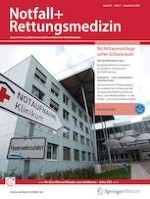01.09.2023 | Leitthema
Epidemiologie, Hintergründe, Zahlen und Fakten zum nichttraumatologischen Schockraummanagement kritisch kranker Patienten
Erschienen in: Notfall + Rettungsmedizin | Ausgabe 7/2023
Einloggen, um Zugang zu erhaltenZusammenfassung
Die Versorgung kritisch kranker Patienten an der Nahtstelle zwischen präklinischer Versorgung durch den Rettungs‑/Notarztdienst und dem Krankenhaus stellt eine große Herausforderung für Notaufnahmen dar. In den letzten Jahren hat sich das nichttraumatologische Schockraummanagement zunehmend professionalisiert. Erste Untersuchungen an Patientenkollektiven aus deutschen Notaufnahmen zeigen die Patientencharakteristika und Kennzahlen in der Versorgung: Rund 0,2–1,6 % aller Notaufnahmekontakte entfallen auf nichttraumatologisch kritisch kranke Schockraumpatienten. Diese Patienten sind im Durchschnitt 66 ± 16 Jahre alt und zu 52–60 % männlichen Geschlechts. Etwa 93 % der Patienten werden über den Rettungs- und Notarztdienst zugeführt. In absteigender Reihenfolge werden die Patienten aufgrund folgender Probleme zugeführt: D‑Probleme 32–41 %, C‑Probleme 31–35 %, B‑Probleme 25–29 %, A‑Probleme 2–4 % und E‑Probleme 0,4–1,1 % (ABCDE „airway“/Atemweg, „breathing“/Atmung, „circulation“/Kreislauf, „disability“/neurologisches Defizit, „exposure“/Exploration). Das Krankheitsspektrum beinhaltet in 29 % der Fälle neurovaskuläre Notfälle, in 28 % kardiovaskuläre Probleme, in 20 % respiratorische Notfälle, in 7 % akute abdominelle Probleme und in jeweils rund 5 % Intoxikationen, Urosepsis und sonstige Notfälle. Bei einem hohen Anteil der Patienten sind invasive Maßnahmen erforderlich, beispielsweise Atemwegssicherung, nichtinvasive und invasive Beatmung, Instrumentierung von intraarteriellen Druckmessungen und zentralen Venenkathetern oder Reanimationsmaßnahmen. Aufgrund unterschiedlich definierter Dokumentationszeitpunkte variiert die Verweildauer im Schockraum zwischen 30 und 148 min. Ein relevanter Anteil der Patienten wird anschließend intensivmedizinisch weiterbehandelt (76–85 %). Die 30-Tage-Mortalität liegt zwischen 19 und 40 %. Komplexe Situationen brauchen Struktur: Die Empfehlungen des Weißbuchs zur „Versorgung kritisch kranker, nicht-traumatologischer Patienten im Schockraum“ der Deutschen Gesellschaft Interdisziplinäre Notfall- und Akutmedizin e. V. (DGINA) geben klare infrastrukturelle Vorgaben zur räumlichen Struktur, Ausstattung und personellen Besetzung. Zukünftige Datenerhebungen müssen auch im multizentrischen Ansatz geeignete klinikindividuelle Versorgungsstrukturen und Alarmierungskriterien, behandelte Patientenkollektive und den Einfluss von Versorgungsalgorithmen untersuchen.
Anzeige














